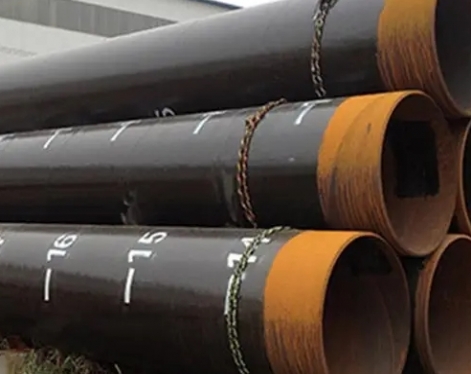Carbon Steel Pipe
Stainless Steel Pipe
Fittings
OCTG
Steel Structure
Value-Added Products
Clad Pipe
Coated Steel Pipe
Technical Data
Photos
- Various organic coatings are in use for pipeline passive external corrosion protection, which are supplemented with active corrosion protection i.e. cathodic protection. The choice and selection of particular coating system is dependent on the various considerations, such as external stresses the coating has to withstand, compatibility with cathodic protection and its current demand, soil characteristics, operating temperature etc.
Internal and External Protective Pipeline Coatings
Oil and gas protective pipeline coatings must be divided into two separate categories, each with its own unique and demanding requirements: Internal Coatings and External Coatings.
Internal Coatings:
Oil and gas fluids contain solid particulates such as sodium chloride, potassium chloride, other salts, carbonates, sulfates, partially polymerized oils, including waxes and paraffins as well as silicas, dirt and greases. Some of these particulates dissolve in the fluid while some remain in suspension. Traveling through pipelines at speeds approaching 200 mph, these particulates become aggressively corrosive projectiles. Coatings designed for internal pipeline application must be engineered to withstand the high impact created by these fast moving particulates.
Types of pipe internal coating
1.Fusion Bonded Epoxy (FBE) Coating
2.Glassflake Coatings (Chemflake, Belzona, etc)
3.PE (Polyethylene) Lining / ROTO Lining
External Coatings:
Oil and gas pipelines are found across the globe. Pipelines can run above ground, underground or they can be immersed in fresh or salt water. Coatings designed for external pipeline applications must be engineered to withstand this wide variety of environmental conditions. Soil stress, soil born chemicals and salt water present formidable challenges to the performance of external pipeline coatings. External coatings also need to be resistant to indigenous bacteria, other flora, waste water and to the chemicals and solvents used in the processing of the hydrocarbons. Pipelines can be found in the hot desert where temperatures often exceed 100°F or in Alaska where temperature can reach as low as -76°F. Ground conditions in the permafrost regions, where ground temperature rarely exceeds 32°F, make subterranean application of pipe very difficult and almost mandate above ground pipeline installations.
Types of pipe external coating
Fusion-bonded epoxy powder coating
Fusion bonded epoxy coating, also known as fusion-bond epoxy powder coating and commonly referred to as FBE coating, is an epoxy-based powder coating that is widely used to protect steel pipe used in pipeline construction from corrosion. FBE coatings are thermoset polymer coatings. The name fusion-bond epoxy is due to resin cross-linking and the application method, which is different from a conventional paint. The resin and hardener components in the dry powder FBE stock remain unreacted at normal storage conditions. At typical coating application temperatures, usually in the range of 180 to 250 °C (356 to 482 °F), the contents of the powder melt and transform to a liquid form. The liquid FBE film wets and flows onto the steel surface on which it is applied, and soon becomes a solid coating by chemical cross-linking, assisted by heat. This process is known as “fusion bonding”. The chemical cross-linking reaction taking place in this case is irreversible. Once the curing takes place, the coating cannot be returned to its original form by any means. Application of further heating will not “melt” the coating and thus it is known as a “thermoset” coating.
Three Layer Poly Ethylene/ Propylene (3LPE/ 3LPP) coating
3LPE/ 3LPP coating system is a multilayer coating composed of three functional components: a high performance fusion bonded epoxy (FBE), followed by a copolymer adhesive and an outer layer of Medium Density Polyethylene (MDPE) or High Density Polyethylene (HDPE), which provides protection against external corrosion.
Coal Tar Enamel (CTE)
CTE coating is a thermoplastic polymeric coating. The CTE coating system is made up of four main components: primer, coal tar enamel, glass fibre inner-wrap and glass fibre outer-wrap.
Current Technology
There are currently four popular methods for coating pipelines:
1) Three-Layer PE (3LPE)/PP (3LPP)
PROS:
Relatively low material cost
Relatively low application cost
CONS:
Requires application of flame to create adhesion
Application of flame in pipeline environments has traditionally been the cause of workplace fires and explosions
Offers limited heat resistance
Maximum 225°F – 250°F
Lacks dimensional stability
Offers borderline hardness
Provides limited resistance to Sulfur, Amines, etc.
Provides limited resistance to Oxygen and other oxidants
2) Fusion Bonded Epoxy (FBE)
PROS:
Excellent chemical resistance
Better dimensional stability – minimal hysteresis
CONS:
Relatively Expensive
Material expensive
Pipe and coating must be heated to 250°F
High labor requirement
3) Coal Tar Enamel (CTE)
PROS:
Extremely inexpensive
CONS:
Minimum protection
Highly Toxic and Flammable
4) Asphalt Enamel and Polyurethane (PUR)
PROS:
Inexpensive
Better than Coal Tar Enamel
Decreased hysteresis
Fast cure
CONS:
Poor chemical resistance
Severe temperature limitations
No dimensional stability









